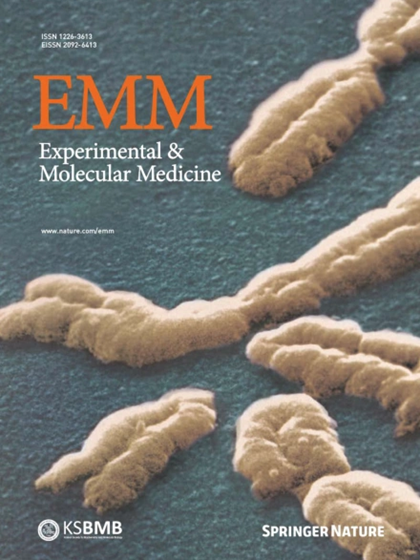NLRP3 inflammasome: a key player in the pathogenesis of life-style disorders
IF 9.5
2区 医学
Q1 BIOCHEMISTRY & MOLECULAR BIOLOGY
引用次数: 0
Abstract
Proinflammatory cytokines and chemokines play a crucial role in regulating the inflammatory response, which is essential for the proper functioning of our immune system. When infections or threats to the body’s defense mechanisms are detected, the innate immune system takes the lead. However, an excessive inflammatory response can lead to the production of high concentrations of cytotoxic molecules, resulting in tissue damage. Inflammasomes are significant contributors to innate immunity, and one of the most extensively studied inflammasome complexes is NOD-like receptor 3 (NLRP3). NLRP3 has a wide range of recognition mechanisms that streamline immune activation and eliminate pathogens. These cytosolic multiprotein complexes are composed of effector, adaptor, and sensor proteins, which are crucial for identifying intracellular bacterial breakdown products and initiating an innate immune cascade. To understand the diverse behavior of NLRP3 activation and its significance in the development of lifestyle-related diseases, one must delve into the study of the immune response and apoptosis mediated by the release of proinflammatory cytokines. In this review, we briefly explore the immune response in the context of lifestyle associated disorders such as obesity, hyperlipidemia, diabetes, chronic respiratory disease, oral disease, and cardiovascular disease. NOD-like receptors (NLRs - proteins that help our immune system fight off harmful invaders) are vital for our health. Their function in T and B cells (types of white blood cells) is less clear. Scientists have found 22 kinds of NLRs in humans, which start different immune and inflammation responses. This study is a detailed review of NLRs, examining their structure, how they are activated, and their role in diseases like obesity, diabetes, and heart problems. It emphasizes that NLRs, particularly the NLRP3 inflammasome (a protein complex involved in inflammation), are key in lifestyle diseases by causing inflammation. The review proposes that focusing on NLRP3 could lead to new treatments for these diseases. This research is a big step in understanding how our natural immune system contributes to chronic diseases and offers potential for new treatments. Future research could further explore the complexities of NLRs and their potential as treatment targets. This summary was initially drafted using artificial intelligence, then revised and fact-checked by the author.


NLRP3炎性体:生活方式疾病发病机制中的关键角色。
促炎细胞因子和趋化因子在调节炎症反应方面起着至关重要的作用,而炎症反应对我们免疫系统的正常运作至关重要。当发现感染或身体防御机制受到威胁时,先天性免疫系统就会发挥主导作用。然而,过度的炎症反应会导致产生高浓度的细胞毒性分子,造成组织损伤。炎症小体是先天性免疫的重要贡献者,其中研究最广泛的炎症小体复合物之一是 NOD 样受体 3(NLRP3)。NLRP3 具有广泛的识别机制,能简化免疫激活并消灭病原体。这些细胞膜多蛋白复合物由效应蛋白、适配蛋白和传感蛋白组成,对于识别细胞内细菌分解产物和启动先天性免疫级联至关重要。要了解 NLRP3 激活的各种行为及其在与生活方式有关的疾病发展中的意义,就必须深入研究由促炎细胞因子释放介导的免疫反应和细胞凋亡。在这篇综述中,我们将简要探讨与肥胖、高脂血症、糖尿病、慢性呼吸道疾病、口腔疾病和心血管疾病等生活方式相关疾病有关的免疫反应。
本文章由计算机程序翻译,如有差异,请以英文原文为准。
求助全文
约1分钟内获得全文
求助全文
来源期刊

Experimental and Molecular Medicine
医学-生化与分子生物学
CiteScore
19.50
自引率
0.80%
发文量
166
审稿时长
3 months
期刊介绍:
Experimental & Molecular Medicine (EMM) stands as Korea's pioneering biochemistry journal, established in 1964 and rejuvenated in 1996 as an Open Access, fully peer-reviewed international journal. Dedicated to advancing translational research and showcasing recent breakthroughs in the biomedical realm, EMM invites submissions encompassing genetic, molecular, and cellular studies of human physiology and diseases. Emphasizing the correlation between experimental and translational research and enhanced clinical benefits, the journal actively encourages contributions employing specific molecular tools. Welcoming studies that bridge basic discoveries with clinical relevance, alongside articles demonstrating clear in vivo significance and novelty, Experimental & Molecular Medicine proudly serves as an open-access, online-only repository of cutting-edge medical research.
 求助内容:
求助内容: 应助结果提醒方式:
应助结果提醒方式:


